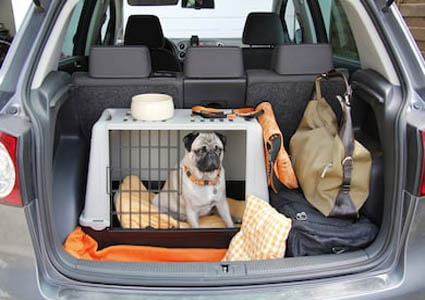What Size Dog Crate Do I Need for My Dog?
“Too Big is Just As Bad As Too Small”
What Size Dog Crate Do I Need for My Dog?
QUESTION:
What Size Dog Crate Do I Need for My Dog?
ANSWER:
Buying the right size dog crate is critical for not only training but for traveling as well. If you get one that is too small, your dog will not be able to get comfortable in it. If it’s too large he’ll be able to make a mess in it and still be able to lay down.

Construction:
Dog crates are made of from two basic materials. The first is a hard plastic that is often called a “Flight Kennel” or “Pet Taxi.” The other is made of a collapsible heavy gauge steel wire.
Because hard plastic units are made from stronger, more durable material they are better for travel. They also provide more protection because the side and top are mostly solid. Commercial carriers require you to use this type of unit if you plan to travel with them.
Steel wire kennels are lightweight, easy to handle and more like a playpen. Consequently they can be better for home use. Because they are a mesh construction they allow better ventilation. It also enables your dog to see and feel connected to everything going on in the room while being in the crate.
Both types are available in several sizes and both can be purchased at big box, pet and discount stores.
Choosing The Right One:
When choosing a crate you need to keep several things in mind. The crate should be just large enough so that your dog can stand up, stretch and turn around in it.
If your dog is still growing, you can still use a crate. Simply purchase one large enough for your dog to use until it reaches about 9 months of age. At that point replace it with a larger one that will accommodate him when he is full grown. If you can’t afford to buy a new kennel that soon, choose a crate that will accommodate its adult size.
Because your dog may have accidents in the large crate there are things you can do to prevent it. One possibility would be to block off the excess crate space. A partition can be made out of a variety of materials. This will keep your dog from eliminating at one end and then retreating to the other end.
Another good idea is to keep your dog on a schedule. Food and water should be removed several hours previous to you leaving your dog in the crate whenever possible. Be sure that you give your dog a chance to relieve itself just before you put it in the crate.
Trainer’s Note:
Your dog will be able to “hold it” for longer periods of time as it gets older. An 8 week old puppy may only be about to “hold it” for an hour or so. At 16 weeks that same puppy will likely make it 3-4 hours.
Need Help?
Contact A Better Dog4U if you have any questions or if you need any help with your training. We will be glad to set up a personal consultation in order to help you any way that we can.
